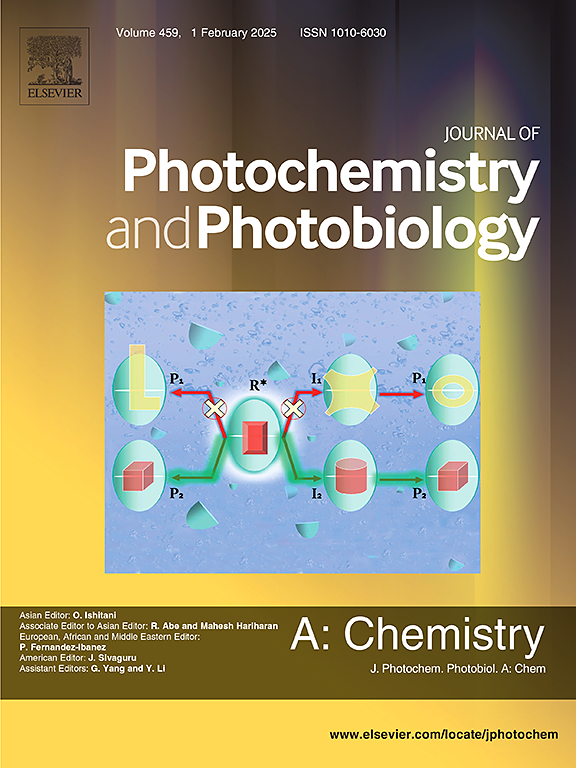A novel fluorescent waterborne polyurethane-based Sm (III) ternary complex improves plant growth in light environments and promotes plant growth
IF 4.1
3区 化学
Q2 CHEMISTRY, PHYSICAL
Journal of Photochemistry and Photobiology A-chemistry
Pub Date : 2025-04-05
DOI:10.1016/j.jphotochem.2025.116426
引用次数: 0
Abstract
Polymeric rare earth complexes have attracted much attention due to their unique luminescence properties and application prospects. However, as an important component of polymeric rare earth complexes, Sm (III) complexes are rarely reported due to the lack of organic ligands matching the energy of Sm (III). Herein, A novel Sm(III) complexes (Sm(MPon)3APhen) emitting red fluorescence is synthesized by using Sm(III) as the central ion and 1-(4-tert-butylphenyl)-3-(4-methoxyphenyl)-1,3-propanone (MPon) and 5-amino-1,10-phenanroline (APhen) as ligands, respectively. Then, A novel waterborne polyurethane-based complex [Sm(MP)3AP]x-WPU with orange-red fluorescence is prepared by modified acetone method using Sm(MPon)3APhen as the end-blocking agent. Compared with Sm(MPon)3APhen, the fluorescence emission peak of [Sm(MP)3AP]x-WPU is blue-shifted, and the fluorescence intensity is significantly enhanced with the increase of the amount of Sm(MPon)3APhen. Notably, the strongest fluorescence emission peak of [Sm(MP)3AP]x-WPU is located in the red light band with the highest photosynthetic absorption efficiency of plants, which could significantly improve the light environment for plant growth and promote plant growth. More importantly, [Sm(MP)3AP]x-WPU is water as a dispersed phase, which is particularly safe and environmentally friendly during storage, transportation and use.
一种新型荧光水性聚氨酯基Sm (III)三元配合物改善植物在光照环境下的生长,促进植物生长
高分子稀土络合物因其独特的发光特性和应用前景而备受关注。然而,作为高分子稀土配合物的重要组成部分,Sm(III)配合物却鲜有报道,原因是缺乏与 Sm(III)能量相匹配的有机配体。本文以 Sm(III) 为中心离子,分别以 1-(4-叔丁基苯基)-3-(4-甲氧基苯基)-1,3-丙酮(MPon)和 5-氨基-1,10-苯丙氨酸(APhen)为配体,合成了一种能发出红色荧光的新型 Sm(III) 复合物(Sm(MPon)3APhen)。然后,以 Sm(MPon)3APhen 为末端封端剂,采用改良丙酮法制备了具有橙红色荧光的新型水性聚氨酯基复合物 [Sm(MP)3AP]x-WPU。与 Sm(MPon)3APhen 相比,[Sm(MP)3AP]x-WPU 的荧光发射峰蓝移,且随着 Sm(MPon)3APhen 用量的增加,荧光强度显著增强。值得注意的是,[Sm(MP)3AP]x-WPU 的最强荧光发射峰位于植物光合吸收效率最高的红光波段,这可以大大改善植物生长的光环境,促进植物生长。更重要的是,[Sm(MP)3AP]x-WPU 以水为分散相,在储存、运输和使用过程中特别安全环保。
本文章由计算机程序翻译,如有差异,请以英文原文为准。
求助全文
约1分钟内获得全文
求助全文
来源期刊
CiteScore
7.90
自引率
7.00%
发文量
580
审稿时长
48 days
期刊介绍:
JPPA publishes the results of fundamental studies on all aspects of chemical phenomena induced by interactions between light and molecules/matter of all kinds.
All systems capable of being described at the molecular or integrated multimolecular level are appropriate for the journal. This includes all molecular chemical species as well as biomolecular, supramolecular, polymer and other macromolecular systems, as well as solid state photochemistry. In addition, the journal publishes studies of semiconductor and other photoactive organic and inorganic materials, photocatalysis (organic, inorganic, supramolecular and superconductor).
The scope includes condensed and gas phase photochemistry, as well as synchrotron radiation chemistry. A broad range of processes and techniques in photochemistry are covered such as light induced energy, electron and proton transfer; nonlinear photochemical behavior; mechanistic investigation of photochemical reactions and identification of the products of photochemical reactions; quantum yield determinations and measurements of rate constants for primary and secondary photochemical processes; steady-state and time-resolved emission, ultrafast spectroscopic methods, single molecule spectroscopy, time resolved X-ray diffraction, luminescence microscopy, and scattering spectroscopy applied to photochemistry. Papers in emerging and applied areas such as luminescent sensors, electroluminescence, solar energy conversion, atmospheric photochemistry, environmental remediation, and related photocatalytic chemistry are also welcome.

 求助内容:
求助内容: 应助结果提醒方式:
应助结果提醒方式:


